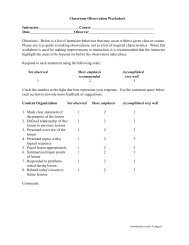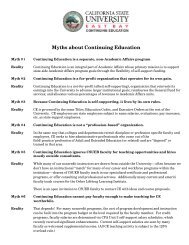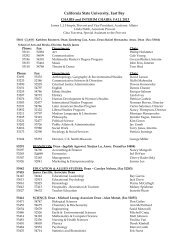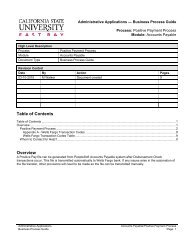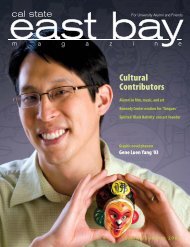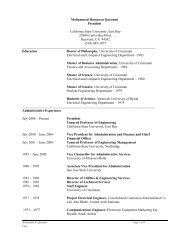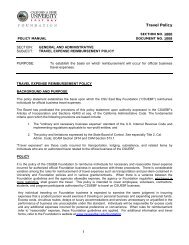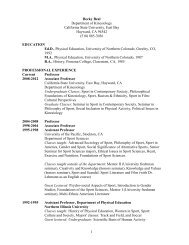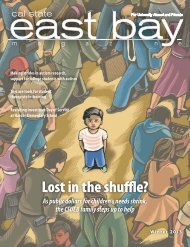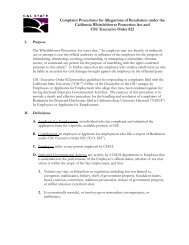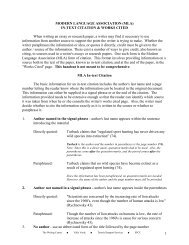Beyond CSI - California State University, East Bay
Beyond CSI - California State University, East Bay
Beyond CSI - California State University, East Bay
You also want an ePaper? Increase the reach of your titles
YUMPU automatically turns print PDFs into web optimized ePapers that Google loves.
features<br />
PHOTOS STEPHANIE SECREST<br />
At her office inside the Alameda County<br />
Court House, far left, District Attorney<br />
Nancy O’Malley ’77 works each day at the<br />
same wooden desk, left, once used by<br />
future Supreme Court Justice Earl Warren.<br />
“<br />
The second day on the<br />
job, I (realized) that this<br />
was a job where you were<br />
helping people — you were<br />
a voice for people who<br />
didn’t have one.<br />
”<br />
Nancy O’Malley ’77<br />
alumna<br />
The law has long been part of O’Malley’s family —<br />
her father was DA of Contra Costa County from 1969<br />
to 1984 — but O’Malley couldn’t imagine a legal career<br />
when she was young. “I spent my grade school years in<br />
trouble for having a big mouth,” she recalls; her outspoken<br />
opinions were considered disrespectful. After high school<br />
she worked for a couple of years at a photo-processing firm<br />
before enrolling at what was then Cal <strong>State</strong> Hayward.<br />
<strong>University</strong> life thrilled her. “Once I got there, I loved<br />
it,” she says. “The classes were stimulating and engaging.”<br />
Volunteering at a rape crisis center led her to a political<br />
science major; “I could see politics at work against victims<br />
of crime,” she recalls. O’Malley idolized Professor J. Malcolm<br />
Smith (whom she remembers as “engaging, smart, nice, and<br />
very accessible”), dreamed of an academic career, and wrote a<br />
senior thesis on upstart gubernatorial candidate Jerry Brown.<br />
But before she could begin graduate school, O’Malley<br />
was diagnosed with lymphoma and began a year of<br />
chemotherapy at the age of 25. “I think it was the best year of<br />
my life,” she says today. “We don’t often get an opportunity<br />
to look at ourselves and our life-and-death issues.”<br />
When O’Malley negotiated her treatment plan, her<br />
doctor quipped that she should be a lawyer. She had heard<br />
it before: Her father had said it with enthusiasm, and her<br />
mother repeated it with exasperation. “There must have<br />
been something that I didn’t recognize in myself, but my<br />
family did,” O’Malley says. She does acknowledge applicable<br />
skills beyond fast talk: In school she was a diplomat, moving<br />
“from the nerds to the cheerleaders to the jocks to the hardasses,”<br />
and her crisis center volunteer work had given her<br />
empathy toward crime victims.<br />
She enrolled in Golden Gate <strong>University</strong> School of Law,<br />
graduating in 1983. Nine months later she applied to the<br />
Alameda County DA’s office. “What drew me here was not so<br />
much public service as the opportunity to go to trial,” she says.<br />
“She cut her teeth on misdemeanor jury trials and was<br />
very good at it,” recalls Carol Corrigan, an associate justice<br />
in the <strong>California</strong> Supreme Court who hired O’Malley into<br />
the DA’s office. “Very early on, Nancy was identified as being<br />
something really special. She was assertive without being<br />
aggressive, very smart without trying to impress you with<br />
how smart she was.” O’Malley, Corrigan adds, always makes<br />
important decisions with both her head and her heart.<br />
O’Malley may have joined the DA to try cases, but “the<br />
second day on the job, I (realized) that this was a job where<br />
you were helping people — you were a voice for people<br />
who didn’t have one,” she says. (The DA’s office not only<br />
prosecutes crimes and fraud; it also helps crime victims access<br />
financial support, counseling, and medical care.) O’Malley<br />
was an active prosecutor — she completed hundreds of<br />
felony preliminary hearings, tried more than 60 cases to<br />
jury verdict, and won convictions in 98 percent of both<br />
misdemeanor and felony cases. She made time, however,<br />
to work at state and county levels on rights and protections<br />
for crime victims and to found the Alameda County Family<br />
Justice Center (ACFJC), which offers a range of services for<br />
victims of violence and abusive behavior under one roof.<br />
(See “Navigating Victims’ Services,” page 24.)<br />
“Tom Orloff, the former DA, was very generous about<br />
letting me run with my ideas,” O’Malley says, “because he<br />
knew I’d get my job done and do this other stuff on top<br />
of it.” (“I have a pretty big capacity to multitask,” she says,<br />
almost oblivious to the understatement.)<br />
“You don’t let everybody run with these things,” Orloff<br />
recalls with a gruff laugh. “But she had a lot of ideas and a<br />
lot of interests.” The more work O’Malley did, the more she<br />
gained Orloff ’s trust. “She had a lot of freedom, because she<br />
earned it,” he says. O’Malley became Orloff ’s chief assistant<br />
in 1999 — a controversial move because she was promoted<br />
over more-senior attorneys.<br />
22 Cal <strong>State</strong> <strong>East</strong> <strong>Bay</strong> Magazine | SPRING 2011<br />
Cal <strong>State</strong> <strong>East</strong> <strong>Bay</strong> Magazine | SPRING 2011<br />
23



